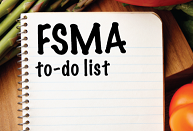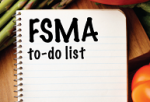With millions of people in the U.S. getting sick each year from foodborne illness, the FDA is continuing to transform the nation’s food safety system with more stringent rules and regulations. In 2011, the Food Safety Modernization Act (FSMA) was signed into law, and consequently, several rules have been finalized to implement the act and ensure food safety across different points in the global supply chain.
The FDA’s Requirements for Additional Traceability Records for Certain Foods, also known as the Food Traceability Final Rule or FSMA 204, establishes additional recordkeeping requirements for entities that manufacture, process, pack or hold foods on the Food Traceability List. The list includes specific foods, such as specific cheeses, eggs, cucumbers, herbs, leafy greens and more, for which extra recordkeeping requirements are reasonable and necessary to protect public health.
The rule was finalized by the FDA on November 15, 2022. It will be enforced beginning January 20, 2026, with routine inspections anticipated to start in 2027, meaning businesses must prepare now to comply with the new requirements.
The goals are to identify and remove potentially contaminated food from the market more quickly, and as a result, prevent the spread of foodborne illnesses and/or fatalities.
Understanding the Food Traceability List
The FDA’s identified foods can be found on the Food Traceability List (FTL). FSMA 204 uses an established set of metrics known as Key Data Elements (KDEs) that relate to various supply chain occurrences known as Critical Tracking Occurrences (CTEs). The CTEs are:
- Harvesting
- Cooling
- Initial Packing (applies to Raw Agricultural Commodities not obtained from a fishing vessel)
- First Land-Based Receiver (applies only to seafood)
- Shipping
- Receiving
- Transformation
If an entity uses any of the above CTEs for any food on the FTL, as well as food that uses an ingredient that remains in the same form (e.g. fresh) on the list, it must comply with the additional recordkeeping requirements.
Preparing for FSMA 204
FSMA 204 became operative in January 2023, 60 days after the publication of the final rule in November 2022. While businesses have three years to become fully compliant (until January 20, 2026), starting the process early is highly recommended as several of the requirements, such as having an established food traceability system, take both time and effort. Meeting the deadline can be extremely challenging if preparations are put off until just before the compliance date.
To prepare for FSMA 204, first, take the time to thoroughly review and understand the rule. Carefully read through the FTL and its overview of ingredients and finished products. Then, make sure that you understand any exemptions that apply to your business.
The next step should be to consult the FDA’s reference guide on CTEs and KDEs to determine which KDEs you must record. Various sets of KDEs may need to be recorded depending on your specific business activities. For example, a food processor could fall under the categories of receiver, transformer, and shipper since it physically acquires products from a supplier, then combines, repackages, relabels, or otherwise transforms the food before shipping it to clients.
In addition to capturing the KDEs, businesses should:
- Create and maintain a traceability plan.
- Maintain records in the form of either the original printed records, electronic records, or true copies. (Records must be legible and stored to prevent loss or deterioration.)
- Ensure traceability records are sent to the FDA within 24 hours of their request (or within a reasonable time to which the FDA has agreed), including any information required to comprehend the data or records. When required to assist during an outbreak, recall or other public health danger, you must deliver an electronic sortable spreadsheet containing pertinent traceability data to the FDA within 24 hours of a request (or within a reasonable timeframe to which the FDA has consented).
Traceability Plan Must-Haves
The food traceability plan should include all procedures used to maintain traceability records, including detailing the format and location of these records in the business. It should also include procedures used to identify foods on the FTL and the subsequent CTEs.
Other key items to include are a process on how traceability lot codes are assigned, points of contact for questions on the traceability system and its records, and supporting documents such as a farm map that indicates the location of the growers or raisers of the food on the FTL (other than eggs). The map must include the position and name of each field or growing area, as well as other details required to pinpoint the sites.
Next Steps
Preparing for FSMA 204 and meeting the requirements can be overwhelming. Several third-party organizations are offering support services. Additionally, the FDA has several resources located on its website, including Frequently Asked Questions, a webinar recording and more.
For businesses unsure about how the rule applies to them and their products, NSF offers an Initial Scoping Workshop that includes a virtual session, which involves reviewing the ingredients and finished products compared to the FTL, a document check (e.g. of the traceability plan), confirmation that all relevant stakeholders have been captured, and access to a video recording explaining the principles of FSMA 204’s traceability requirements. A recommendation will also be made if a FSMA 204 Readiness Assessment is needed.
Businesses who already know their products fall under the FTL can opt to start with a full FSMA 204 Readiness Assessment, which ensures you have taken all the steps necessary and helps you identify any corrective actions/controls needed to ensure compliance with the rule.
Effectively communicating the food traceability plan and coaching supply chain partners on new processes is a critical component to meeting compliance. Label harmonization must be completed to properly track and secure the required information from suppliers.
Though paper records are permitted under the rule, businesses should consider leveraging technology to assist them with complying with the requirements. Consider investing in a platform that can automate data gathering and securely save information so it can be easily retrieved if needed. On-demand traceback and trace forward features are especially important, as in the event of an investigation or recall, immediate product tracing capabilities are essential.
While FSMA 204 will require entities across the food industry to comply with the new requirements, it will contribute to a stronger and more resilient global food supply chain.







